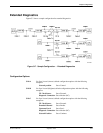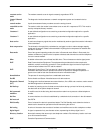
Glossary
Glossary-53910-A2-GN32-40 September 1998
A shared boundary between functional units.
International Telecommunications Union. The telecommunications agency of the United Nations,
established to provide standardized communications procedures and practices. Before
March 1993 it was called CCITT.
The Telecommunications Standardization Sector of the International Telecommunications Union,
an advisory committee established by the United Nations to recommend communications
standards and policies. Before March 1993 it was called CCITT.
A jack used for leased-line networks. Pins 1 and 2 are the transmit pair and Pins 7 and 8 are the
receive pair.
Kilobits per second. One kilobit is usually taken to be 1,024 bits.
A set of seven keys surrounding the DCP’s LCD. These keys are used to select configuration
options and to maneuver through the DCP menu.
Liquid Crystal Display. Thin glass plates containing liquid crystal material. When voltage is
applied, the amount of light able to pass through the glass plates is altered so that messages
can be displayed.
A private line connection exclusively for the user. No dialing is necessary.
Light Emitting Diode. A light or status indicator that glows in response to the presence of a
certain condition (e.g., an alarm).
The physical connection between one location and another used for data transmission.
A test in which the modem’s transmit voice frequency (VF) signal is looped to its receiver.
A disconnect effected when the modem receives an extended space from a remote modem.
When a modem is commanded to disconnect, it transmits a continuous space to the opposite
modem before disconnecting.
A diagnostic procedure that sends a test message back to its origination point. Used to test
various portions of a data link in order to isolate an equipment or data line problem.
The structure containing the menu hierarchy starting at a Top-Level menu and extending down to
various device functions.
In a multipoint network, several different data rates from tributary modems’ transmitters
communicating with one control modem.
Microcom Networking Protocol. Levels 2-4 of this protocol, similar to ITU V.42, detect and correct
data errors caused by telephone line noise and signal distortion. Level 5, similar to ITU V.42bis,
includes data compression.
MOdulator/DEModulator. A device used to convert data from a digital signal to an analog signal
so that data can be transmitted over a telephone line. Once the data is received, the analog
signal is converted back into a digital signal.
The process of varying some characteristics (usually amplitude, frequency, and/or phase) of a
carrier wave to form data transmissions.
A device used to interleave or simultaneously transmit multiple independent data streams into a
single high-speed data stream. Multiplexing techniques include FDM (frequency division
multiplexing), TDM (time division multiplexing), and STDM (statistical time division multiplexing).
A circuit connecting one control modem with one or more tributary modems.
A configuration of data processing devices used for information exchange.
The customer-assigned diagnostic address of a modem.
interface
ITU
ITU-T
JM8
kbps
keypad
LCD
leased line
LED
link
local analog loopback
long space disconnect
loopback
menu tree
mixed inbound rates
MNP
modem
modulation
multiplexer (mux)
multipoint line
network
network management
address


















